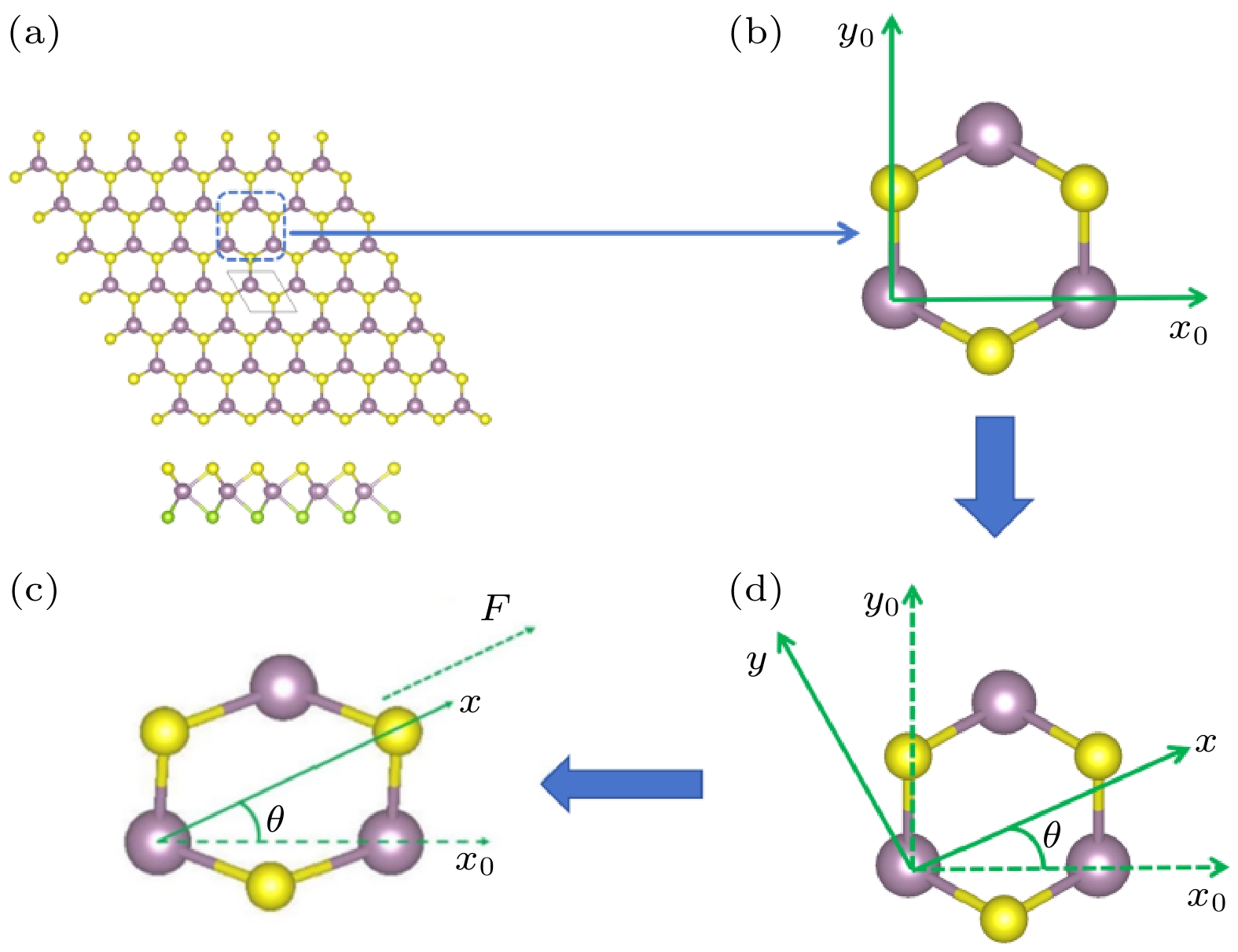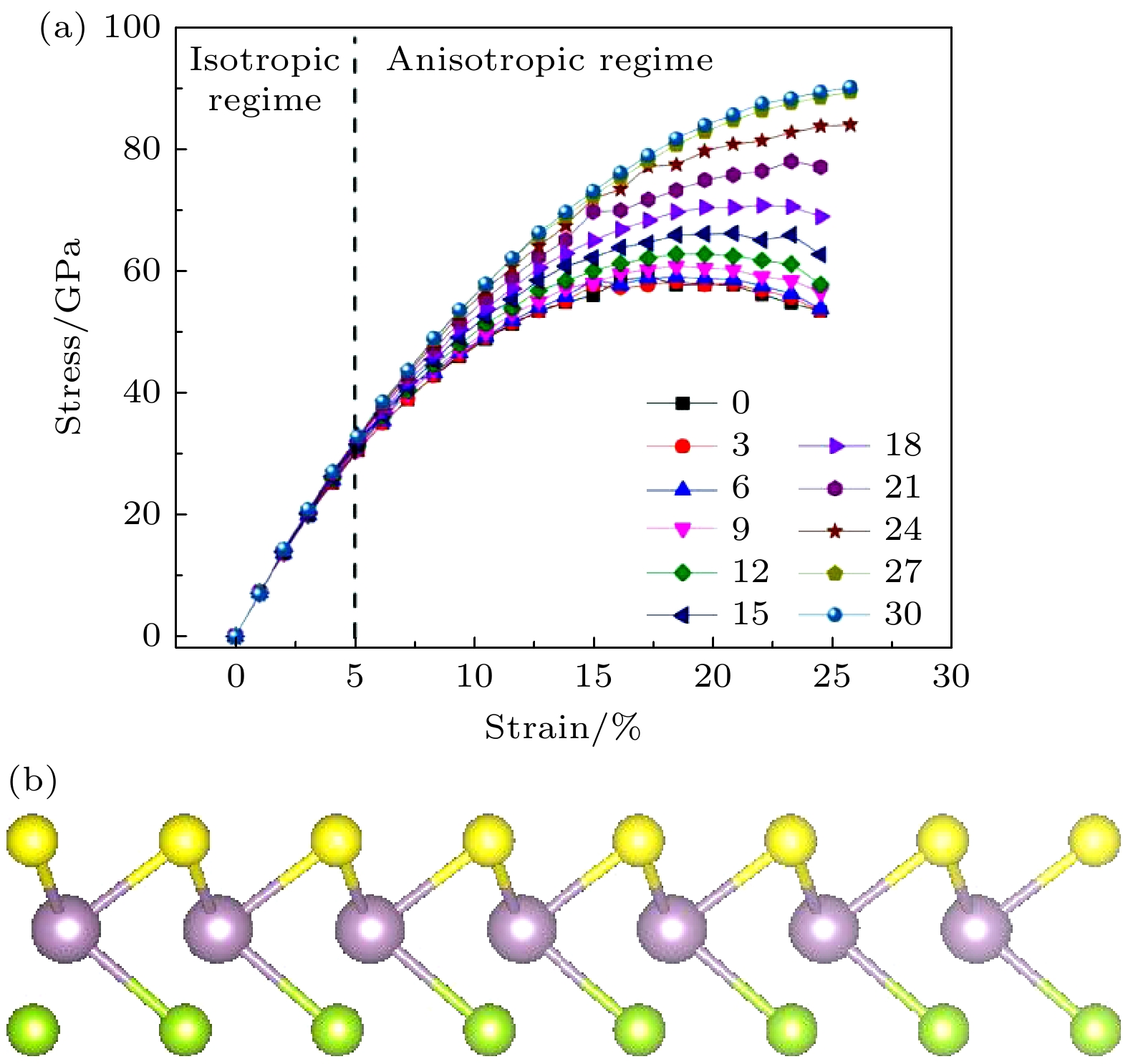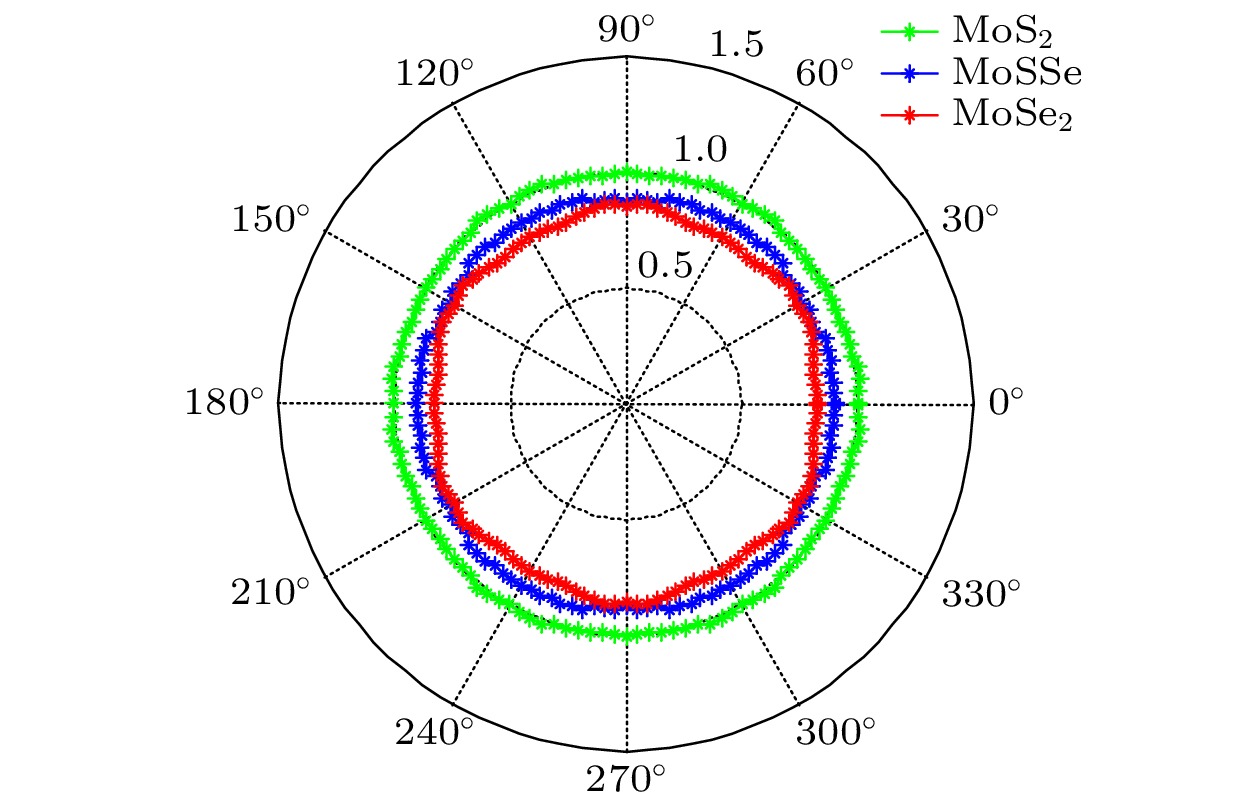-
单层Janus MoSSe不同于其母体材料MoS2和MoSe2, 由于其结构的不对称性, 因此研究其在单轴应变下独特的力学性质具有重要意义. 采用基于密度泛函理论的第一性原理方法, 计算了对称性破坏下的单层Janus MoSSe材料在不同手性角下单轴拉伸应变的力学性质. 结果表明, 当应变不超过5%时, 应力-应变曲线在不同手性角下表现出各向同性的特点; 当应变超过5%且Mo—S键与Mo—Se键未断裂时, 不同手性角下的应力-应变曲线表现出较强的各向异性的力学响应. 单层Janus MoSSe的强度和韧度具有高度的各向异性和手性依赖. 相比之下, 其平面内刚度在不同的手性角下保持不变. 计算还表明, 包含电子间多体相互作用的第一性原理计算方法在确定这种材料的强度和韧度方面具有重要的作用. 本研究为单层Janus MoSSe基纳米力学器件的构建和开发提供了参考.
-
关键词:
- 单层Janus MoSSe /
- 应力 /
- 应变 /
- 力学性质 /
- 第一性原理计算
The monolayer Janus MoSSe is different from its parent materials MoS2 and MoSe2. It is of great significance to study the unique mechanical properties of monolayer Janus MoSSe under uniaxial strain due to the asymmetry of its structure. Theoretical studies can provide useful support for improving the mechanical properties of monolayer Janus materials under strain. By using the first-principles method based on the density functional theory and combining the classical mechanics analysis, the mechanical properties of monolayer Janus MoSSe with broken symmetry under uniaxial tensile strain at different chiral angles are investigated. The results show that the stress-strain curves are isotropic at different chiral angles when the strain is less than 5%. When the strain exceeds 5% and the Mo—S bond and Mo—Se bond are not broken, the stress-strain curves at different chiral angles show strong anisotropic responses. The strength and toughness of monolayer Janus MoSSe are highly anisotropy- and chirality-dependent. In contrast, its in-plane stiffness remains constant at different chiral angles. By comparing the results from the first-principles method of quantum mechanics with those from the classical mechanics method, it is shown that first-principles calculations involving many-body interactions between electrons play an important role in determining the strength and toughness of this material. This is because the first-principles method can incorporate more accurately the many-body interactions between electrons. This study provides guidance for constructing and developing monolayer Janus MoSSe based nanomechanical devices.-
Keywords:
- monolayer Janus MoSSe /
- stress /
- strain /
- mechanical properties /
- first-principles calculations
[1] Novoselov K S, Geim A K, Morozov S V, Jiang D, Zhang Y, Dubonos S V, Grigorieva I V, Firsov A A 2004 Science 306 666
 Google Scholar
Google Scholar
[2] Balandin A A, Ghosh S, Bao W Z, Calizo I, Teweldebrhan D, Miao F, Lau C N 2008 Nano Lett. 8 902
 Google Scholar
Google Scholar
[3] Wang S, Ang P K, Wang Z Q, Tang A L L, Thong J T L, Loh K P 2010 Nano Lett. 10 92
 Google Scholar
Google Scholar
[4] Osada M, Sasaki T 2012 Adv. Mater. 24 210
 Google Scholar
Google Scholar
[5] Lu A Y, Zhu H Y, Xiao J, et al. 2017 Nat. Nanotech. 12 744
 Google Scholar
Google Scholar
[6] Zhang J, Jia S, Kholmanov I, et al. 2017 ACS Nano 11 8192
 Google Scholar
Google Scholar
[7] Dong L, Shenoy V B 2017 ACS Nano 11 8242
 Google Scholar
Google Scholar
[8] Guan Z Y, Ni S, Hu S L 2018 J. Phys. Chem. C 122 6209
 Google Scholar
Google Scholar
[9] Ji Y, Yang M, Lin H, Hou T, Wang L, Li Y, Lee S T 2018 J. Phys. Chem. C 122 3123
 Google Scholar
Google Scholar
[10] Chen W, Qu L, Yao L, Hou X, Shi X, Pan H 2018 J. Mater. Chem. A 6 8021
 Google Scholar
Google Scholar
[11] Er D Q, Ye H, Frey N C, Kumar H, Lou J, Shenoy V B 2018 Nano lett. 18 3943
 Google Scholar
Google Scholar
[12] Lakshmy S, Mondal B, Kalarikkal N, Rout C S, Chakraborty B 2024 Adv. Powder Mater. 3 100204
 Google Scholar
Google Scholar
[13] Hossain M Z, Ahmed T, Silverman B, et al. 2018 J. Mech. Phys. Solids 110 118
 Google Scholar
Google Scholar
[14] Ahmed T, Zhang Z, McDermitt C, Houssain Z M 2018 J. Appl. Phys. 124 185108
 Google Scholar
Google Scholar
[15] 张宇航, 李孝宝, 詹春晓, 王美芹, 浦玉学 2023 物理学报 72 046201
 Google Scholar
Google Scholar
Zhang Y H, Li X B, Zhan C X, Wang M Q, Pu Y X 2023 Acta Phys. Sin. 72 046201
 Google Scholar
Google Scholar
[16] Kresse G, Joubert D 1999 Phys. Rev. B 59 1758
[17] Blöchl P E 1994 Phys. Rev. B 50 17953
 Google Scholar
Google Scholar
[18] Kresse G, Hafner J 1993 Phys. Rev. B 47 558
 Google Scholar
Google Scholar
[19] Kresse G, Furthmüller J 1996 Phys. Rev. B 54 11169
 Google Scholar
Google Scholar
[20] Perdew J P, Burke K, Ernzerhof M 1996 Phys. Rev. Lett. 77 3865
 Google Scholar
Google Scholar
[21] Perdew J P, Chevary J A, Vosko S H, Jackson K A, Pederson M R, Singh D J, Fiolhais C 1992 Phys. Rev. B 46 6671
 Google Scholar
Google Scholar
[22] Tang X, Li S, Ma Y, Du A, Liao T, Gu Y, Kou L 2018 J. Phys. Chem. C 122 19153
 Google Scholar
Google Scholar
[23] Shi W W, Wang Z G 2018 J. Phys. : Condens. Matt. 30 215301
 Google Scholar
Google Scholar
-
图 1 (a) 单层Janus MoSSe的俯视图和侧视图, 图中实线的菱形为计算时的原胞; (b) x0, y0 坐标轴示意图; (c), (d) 手性角θ的定义和在手性角θ下施加在晶格上负载的方向, Mo, S和Se原子分别用紫色、黄色和绿色小球表示
Fig. 1. (a) Top view and side view of Janus monolayer MoSSe, the solid line rhombuses represent the unit cell; (b) x0, y0 coordinate system; (c), (d) definition of chiral angle θ and the loading direction applied on the lattice with a chiral angle θ, the Mo, S and Se atoms are shown by purple, yellow and green balls, respectively.
图 2 (a) Janus MoSSe在不同手性角下(0°—30°范围)的应力-应变曲线, 垂直虚线表示晶格各向同性和各向异性响应之间的边界; (b) 单层Janus MoSSe断裂结构的侧视图
Fig. 2. Stress-strain curve under different chiral angels (between 0°–30°) of Janus MoSSe, the vertical dashed line indicates the boundary between isotropic and anisotropic response of the lattice; (b) side view of the fractured structure of monolayer Janus MoSSe.
图 3 MoSSe以及其母体材料MoS2和MoSe2的归一化平面内刚度的手性角依赖关系C1(θ)/C1(0°), 归一化因子取自MoS2的C1(0°), 其值为121.01 N/m
Fig. 3. Chiral angle dependence of normalized in-plane stiffness C1(θ)/C1(0°) of MoSSe and its parent materials MoS2 and MoSe2, the normalization factor is taken from C1(0°) of MoS2, which has a value of 121.01 N/m.
图 4 单层Janus MoSSe的(a)强度和(b)韧度与手性角关系. DFT的第一性原理计算结果为红点所示, 蓝色曲线为近似的线性模型的结果
Fig. 4. Chiral angle dependence of (a) strength and (b) toughness of monolayer Janus MoSSe. DFT first-principles calculation results are plotted in red dots, and the results of approximate linear model are given by blue curves.
表 1 手性角为0°—30°时的临界应变值
Table 1. Critical strains for chiral angles from 0° to 30°.
手性角/(°) 临界应变/% 手性角/(°) 临界应变/% 0 17.258 18 22.019 3 18.43 21 23.239 6 18.43 24 25.716 9 18.43 27 25.716 12 18.43 30 25.716 15 20.811 -
[1] Novoselov K S, Geim A K, Morozov S V, Jiang D, Zhang Y, Dubonos S V, Grigorieva I V, Firsov A A 2004 Science 306 666
 Google Scholar
Google Scholar
[2] Balandin A A, Ghosh S, Bao W Z, Calizo I, Teweldebrhan D, Miao F, Lau C N 2008 Nano Lett. 8 902
 Google Scholar
Google Scholar
[3] Wang S, Ang P K, Wang Z Q, Tang A L L, Thong J T L, Loh K P 2010 Nano Lett. 10 92
 Google Scholar
Google Scholar
[4] Osada M, Sasaki T 2012 Adv. Mater. 24 210
 Google Scholar
Google Scholar
[5] Lu A Y, Zhu H Y, Xiao J, et al. 2017 Nat. Nanotech. 12 744
 Google Scholar
Google Scholar
[6] Zhang J, Jia S, Kholmanov I, et al. 2017 ACS Nano 11 8192
 Google Scholar
Google Scholar
[7] Dong L, Shenoy V B 2017 ACS Nano 11 8242
 Google Scholar
Google Scholar
[8] Guan Z Y, Ni S, Hu S L 2018 J. Phys. Chem. C 122 6209
 Google Scholar
Google Scholar
[9] Ji Y, Yang M, Lin H, Hou T, Wang L, Li Y, Lee S T 2018 J. Phys. Chem. C 122 3123
 Google Scholar
Google Scholar
[10] Chen W, Qu L, Yao L, Hou X, Shi X, Pan H 2018 J. Mater. Chem. A 6 8021
 Google Scholar
Google Scholar
[11] Er D Q, Ye H, Frey N C, Kumar H, Lou J, Shenoy V B 2018 Nano lett. 18 3943
 Google Scholar
Google Scholar
[12] Lakshmy S, Mondal B, Kalarikkal N, Rout C S, Chakraborty B 2024 Adv. Powder Mater. 3 100204
 Google Scholar
Google Scholar
[13] Hossain M Z, Ahmed T, Silverman B, et al. 2018 J. Mech. Phys. Solids 110 118
 Google Scholar
Google Scholar
[14] Ahmed T, Zhang Z, McDermitt C, Houssain Z M 2018 J. Appl. Phys. 124 185108
 Google Scholar
Google Scholar
[15] 张宇航, 李孝宝, 詹春晓, 王美芹, 浦玉学 2023 物理学报 72 046201
 Google Scholar
Google Scholar
Zhang Y H, Li X B, Zhan C X, Wang M Q, Pu Y X 2023 Acta Phys. Sin. 72 046201
 Google Scholar
Google Scholar
[16] Kresse G, Joubert D 1999 Phys. Rev. B 59 1758
[17] Blöchl P E 1994 Phys. Rev. B 50 17953
 Google Scholar
Google Scholar
[18] Kresse G, Hafner J 1993 Phys. Rev. B 47 558
 Google Scholar
Google Scholar
[19] Kresse G, Furthmüller J 1996 Phys. Rev. B 54 11169
 Google Scholar
Google Scholar
[20] Perdew J P, Burke K, Ernzerhof M 1996 Phys. Rev. Lett. 77 3865
 Google Scholar
Google Scholar
[21] Perdew J P, Chevary J A, Vosko S H, Jackson K A, Pederson M R, Singh D J, Fiolhais C 1992 Phys. Rev. B 46 6671
 Google Scholar
Google Scholar
[22] Tang X, Li S, Ma Y, Du A, Liao T, Gu Y, Kou L 2018 J. Phys. Chem. C 122 19153
 Google Scholar
Google Scholar
[23] Shi W W, Wang Z G 2018 J. Phys. : Condens. Matt. 30 215301
 Google Scholar
Google Scholar
计量
- 文章访问数: 3683
- PDF下载量: 46
- 被引次数: 0














 下载:
下载:



